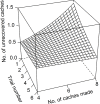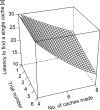Observational spatial memory in wolves and dogs
- PMID: 37703235
- PMCID: PMC10499247
- DOI: 10.1371/journal.pone.0290547
Observational spatial memory in wolves and dogs
Abstract
Social learning is highly adaptive in transmitting essential information between individuals in many species. While several mechanisms have been observed, less is known about how much animals can remember. However, results on observational spatial memory among caching species, i.e. a form of social learning allowing individuals to remember and pilfer food caches made by others, suggest that this ability correlates with their social organization. Both wolves and their domesticated form, dogs, are social species known to make food caches, and previous studies have shown that they both can use observational spatial memory abilities to find hidden food. In order to test how much socially transmitted information wolves and dogs can remember, we tested both species in a task requiring them to find 4, 6 or 8 caches after they observed a human hiding food items, or after a control condition where they could not observe the hiding. We found that both wolves and dogs retrieved more caches and were more efficient for the first few caches if they observed the hiding than in the control condition, suggesting that they did not simply rely on scent to find the rewards. Interestingly, wolves outperformed dogs irrespective of whether the caching could be observed or not. We suggest that this result is due to a difference in motivation/persistence between wolves and dogs rather than observational spatial memory.
Copyright: © 2023 Vetter et al. This is an open access article distributed under the terms of the Creative Commons Attribution License, which permits unrestricted use, distribution, and reproduction in any medium, provided the original author and source are credited.
Conflict of interest statement
No authors have competing interests.
Figures







Similar articles
-
Current desires of conspecific observers affect cache-protection strategies in California scrub-jays and Eurasian jays.Curr Biol. 2017 Jan 23;27(2):R51-R53. doi: 10.1016/j.cub.2016.11.020. Curr Biol. 2017. PMID: 28118584 Free PMC article.
-
Short-term observational spatial memory in Jackdaws (Corvus monedula) and Ravens (Corvus corax).Anim Cogn. 2008 Oct;11(4):691-8. doi: 10.1007/s10071-008-0160-5. Epub 2008 May 27. Anim Cogn. 2008. PMID: 18504626 Free PMC article.
-
Evidence against observational spatial memory for cache locations of conspecifics in marsh tits Poecile palustris.Behav Ecol Sociobiol. 2017;71(2):34. doi: 10.1007/s00265-016-2264-2. Epub 2017 Jan 10. Behav Ecol Sociobiol. 2017. PMID: 28127116 Free PMC article.
-
Elements of episodic-like memory in animals.Philos Trans R Soc Lond B Biol Sci. 2001 Sep 29;356(1413):1483-91. doi: 10.1098/rstb.2001.0947. Philos Trans R Soc Lond B Biol Sci. 2001. PMID: 11571038 Free PMC article. Review.
-
Social cognition by food-caching corvids. The western scrub-jay as a natural psychologist.Philos Trans R Soc Lond B Biol Sci. 2007 Apr 29;362(1480):507-22. doi: 10.1098/rstb.2006.1992. Philos Trans R Soc Lond B Biol Sci. 2007. PMID: 17309867 Free PMC article. Review.
Cited by
-
Investigating the relationship between physical cognitive tasks and a social cognitive task in a wild bird.Anim Cogn. 2024 Jul 26;27(1):52. doi: 10.1007/s10071-024-01892-4. Anim Cogn. 2024. PMID: 39060612 Free PMC article.
References
-
- Chapman TL, Holcomb MP, Spivey KL, Sehr EK, Gall BG. A Test of Local Enhancement in Amphibians. Ethology. 2015;121(3):308–14. Available from: 10.1111/eth.12337 - DOI
-
- Mersmann D, Tomasello M, Call J, Kaminski J, Taborsky M. Simple Mechanisms Can Explain Social Learning in Domestic Dogs (Canis familiaris). Ethology. 2011;117(8):675–90. Available from: 10.1111/j.1439-0310.2011.01919.x - DOI
Publication types
MeSH terms
Grants and funding
LinkOut - more resources
Full Text Sources


